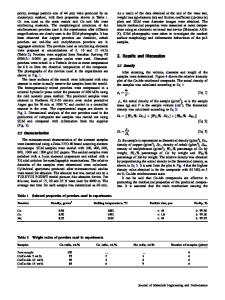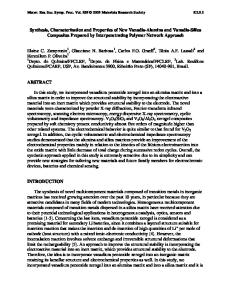Synthesis and Mechanical Characterization of Aluminum Based Composites Prepared by Powder Metallurgy
- PDF / 586,021 Bytes
- 6 Pages / 432 x 648 pts Page_size
- 24 Downloads / 440 Views
Mater. Res. Soc. Symp. Proc. Vol. 1243 © 2010 Materials Research Society
Synthesis and Mechanical Characterization of Aluminum Based Composites Prepared by Powder Metallurgy I. Estrada-Guel1,2, J. L. Cardoso2, C. Careño-Gallardo1,2, J. M. Herrera-Ramírez1 and R. MartínezSánchez1. 1
Centro de Investigación en Materiales Avanzados (CIMAV), Laboratorio Nacional de Nanotecnología, Miguel de Cervantes No. 120, CP 31109, Chihuahua, Chih., México. 2 Universidad Autónoma Metropolitana, Depto. de Materiales, Av. San Pablo # 180, Col Reynosa-Tamaulipas CP 02200, México, D. F. ABSTRACT Aluminum-based composites prepared from pure Al powder and previously Cu metallized graphite are fabricated by a solid state route and are characterized by X-ray diffraction and scanning electron microscopy in order to follow their microstructural evolution. Composites are processed using powder metallurgy technique in order to obtain cylindrical samples to carry out mechanical testing. Microstructural and mechanical characterizations reveal that, by milling, a homogeneous dispersion of insoluble particles into the Al matrix is obtained; this produces an important improvement in hardness and strength with respect to an un-milled sample. Milling intensity and particle concentration have an important effect on the mechanical properties of the synthesized composites. INTRODUCTION Aluminum and its alloys have a wide diversity of industrial applications because of their light weight and corrosion resistance. However, their low stiffness, yield strength and resistance to wear and tear sometimes limit their use. Al-based composites are excellent alternatives to overcome these disadvantages, since they are cheap compared with other low density alloys (such as Mg or Ti), and have excellent performance [1]. On the other hand, graphite (Cg) has been recognized as a high strength, low density material. Because of its high strength to mass ratio [2] along with its excellent structural stability and mechanical performance at high temperatures, graphite has been used as a reinforcement material in polymer based composites [3]. Although the preparation of such composites by melting and casting routes is the most economical, it is associated with problems related to the poor wetting of ceramic particles [2, 4]. Therefore, the introduction and retention of graphite particles in molten Al is difficult, resulting in inhomogeneous distribution, inadequate Al/Cg bonding and formation of porosity at the matrix/Cg interface [5]. Powder metallurgy (PM) is a technology capable of providing competitive components at low cost with high material efficiency [6]; basically it consists of mixing elements or alloy powders, compacting the mixture in a die, and sintering the compacts at just below their melting point in a controlled-atmosphere furnace to bond the particles. However, raw materials only consist of simple powder mixtures. Powder mixing is a critical step [7] since it controls the distribution of particles and porosity, which influence the composite mechanical beh
Data Loading...










